中国新年 中英双语介绍
中国传统文化春节习俗中英双语介绍(写作必备)

中国传统文化春节习俗中英双语介绍年的来历关于过年还有个传说,中国的新年跟打怪有关。
“年”其实是神话中的一种怪兽,会在新年的第一天来吃小孩子、牲口和粮食。
为了保护大家不受伤害,村民们将食物放在门口供“年”享用。
因为“年”惧怕红色和炮竹,过年大家便会挂红灯笼,放鞭炮。
Legend holds that the Chinese New Year began with a battle against a mythicalbeast called the Nian, who would come on the first day of the new year to eatchildren, livestock, and crops. In order to protect themselves from the Nian, villages put food in front of their doors believing that the creature would eat that and leave everything else alone. It was believed that the Nian was afraid of the colour red and firecrackers, so people would hang red lanterns outside and set off firecrackers.Little New Year, which falls the 23rd day of the 12th month in the Lunar calendar, is also known as the Festival of the Kitchen God, the deity who oversees the moral character of each household.小年农历腊月二十三日是小年,也是祭灶节。
介绍中国春节的英语作文(精选3篇)
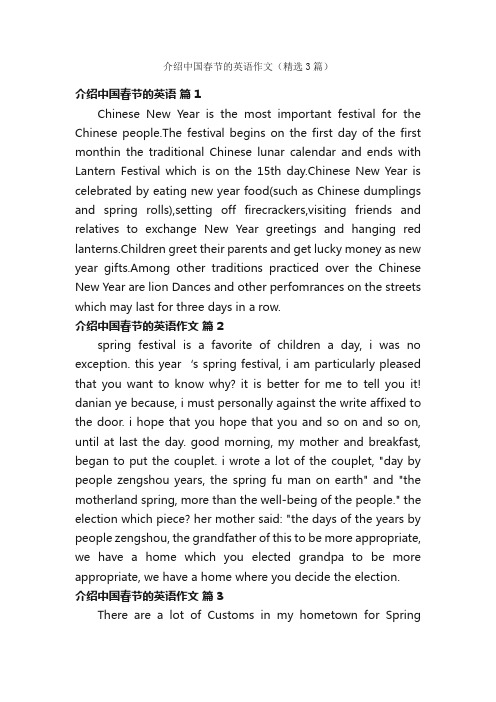
介绍中国春节的英语作文(精选3篇)介绍中国春节的英语篇1Chinese New Year is the most important festival for the Chinese people.The festival begins on the first day of the first monthin the traditional Chinese lunar calendar and ends with Lantern Festival which is on the 15th day.Chinese New Year is celebrated by eating new year food(such as Chinese dumplings and spring rolls),setting off firecrackers,visiting friends and relatives to exchange New Year greetings and hanging red lanterns.Children greet their parents and get lucky money as new year gifts.Among other traditions practiced over the Chinese New Year are lion Dances and other perfomrances on the streets which may last for three days in a row.介绍中国春节的英语作文篇2spring festival is a favorite of children a day, i was no exception. this year‘s spring festival, i am particularly pleased that you want to know why? it is better for me to tell you it! danian ye because, i must personally against the write affixed to the door. i hope that you hope that you and so on and so on, until at last the day. good morning, my mother and breakfast, began to put the couplet. i wrote a lot of the couplet, "day by people zengshou years, the spring fu man on earth" and "the motherland spring, more than the well-being of the people." the election which piece? her mother said: "the days of the years by people zengshou, the grandfather of this to be more appropriate, we have a home which you elected grandpa to be more appropriate, we have a home where you decide the election.介绍中国春节的英语作文篇3There are a lot of Customs in my hometown for SpringFestival. I dont believe you!In the Spring Festival, both men and women and young men and women wear beautiful new clothes, with simple smiles on their faces to welcome the coming of the new year. Red red couplets and New Year pictures were posted in each family. All drums. The children go to the new year and send the cards. At night, everywhere decorated. Famous shops, to hang out hundreds of lights, lantern, lamp, whats ice, shadeng...... Every kind of。
给外国朋友介绍中国新年的英语作文
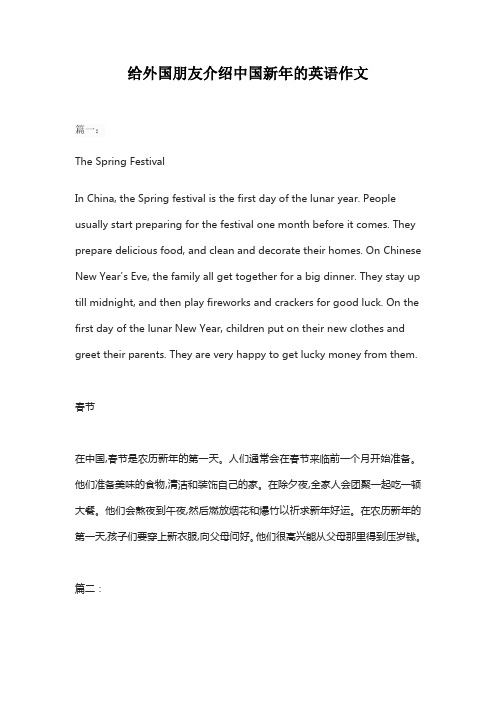
给外国朋友介绍中国新年的英语作文篇一:The Spring FestivalIn China, the Spring festival is the first day of the lunar year. People usually start preparing for the festival one month before it comes. They prepare delicious food, and clean and decorate their homes. On Chinese New Year's Eve, the family all get together for a big dinner. They stay up till midnight, and then play fireworks and crackers for good luck. On the first day of the lunar New Year, children put on their new clothes and greet their parents. They are very happy to get lucky money from them.春节在中国,春节是农历新年的第一天。
人们通常会在春节来临前一个月开始准备。
他们准备美味的食物,清洁和装饰自己的家。
在除夕夜,全家人会团聚一起吃一顿大餐。
他们会熬夜到午夜,然后燃放烟花和爆竹以祈求新年好运。
在农历新年的第一天,孩子们要穿上新衣服,向父母问好。
他们很高兴能从父母那里得到压岁钱。
篇二:The Spring Festival is the most important festival in Chinese culture. Unlike the Gregorian calendar which starts on January 1st, the Chinese New Year falls on different dates each year based on the lunar cycle. Celebrations typically last for around two weeks.In the lead up to the new year, families thoroughly clean their homes to sweep away any ill-fortune and make way for incoming good luck. They also decorate with red lanterns, couplets, and paper cuttings. On New Year's Eve, families reunite for an annual reunion dinner featuring dishes like dumplings, fish, and niangao (glutinous rice cake) which symbolize prosperity.After midnight on New Year's Eve, firecrackers are set off to scare away evil spirits. People stay up late playing games like mahjong and poker. On the first day of the new year, children receive red envelopes filled with money from their elders as a blessing for the year ahead.For the next two weeks, families visit relatives and friends, feast on special foods, let off firecrackers, watch lion and dragon dances, and enjoy various festivities. The final celebration is the Lantern Festival, which features beautiful lantern displays and eating tang yuan (glutinous rice balls).春节是中国文化中最重要的传统节日。
中国新年的中英文描述
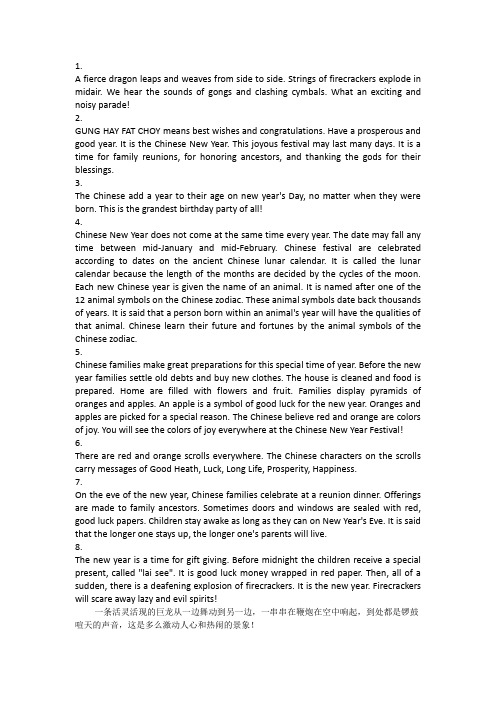
1.A fierce dragon leaps and weaves from side to side. Strings of firecrackers explode in midair. We hear the sounds of gongs and clashing cymbals. What an exciting and noisy parade!2.GUNG HAY FAT CHOY means best wishes and congratulations. Have a prosperous and good year. It is the Chinese New Year. This joyous festival may last many days. It is a time for family reunions, for honoring ancestors, and thanking the gods for their blessings.3.The Chinese add a year to their age on new year's Day, no matter when they were born. This is the grandest birthday party of all!4.Chinese New Year does not come at the same time every year. The date may fall any time between mid-January and mid-February. Chinese festival are celebrated according to dates on the ancient Chinese lunar calendar. It is called the lunar calendar because the length of the months are decided by the cycles of the moon. Each new Chinese year is given the name of an animal. It is named after one of the 12 animal symbols on the Chinese zodiac. These animal symbols date back thousands of years. It is said that a person born within an animal's year will have the qualities of that animal. Chinese learn their future and fortunes by the animal symbols of the Chinese zodiac.5.Chinese families make great preparations for this special time of year. Before the new year families settle old debts and buy new clothes. The house is cleaned and food is prepared. Home are filled with flowers and fruit. Families display pyramids of oranges and apples. An apple is a symbol of good luck for the new year. Oranges and apples are picked for a special reason. The Chinese believe red and orange are colors of joy. You will see the colors of joy everywhere at the Chinese New Year Festival! 6.There are red and orange scrolls everywhere. The Chinese characters on the scrolls carry messages of Good Heath, Luck, Long Life, Prosperity, Happiness.7.On the eve of the new year, Chinese families celebrate at a reunion dinner. Offerings are made to family ancestors. Sometimes doors and windows are sealed with red, good luck papers. Children stay awake as long as they can on New Year's Eve. It is said that the longer one stays up, the longer one's parents will live.8.The new year is a time for gift giving. Before midnight the children receive a special present, called "lai see". It is good luck money wrapped in red paper. Then, all of a sudden, there is a deafening explosion of firecrackers. It is the new year. Firecrackers will scare away lazy and evil spirits!一条活灵活现的巨龙从一边舞动到另一边,一串串在鞭炮在空中响起,到处都是锣鼓喧天的声音,这是多么激动人心和热闹的景象!“恭喜发财”意思是希望或祝福对方在新的一年能够赚多多的钱,这里指的是中国新年。
春节中英文简介
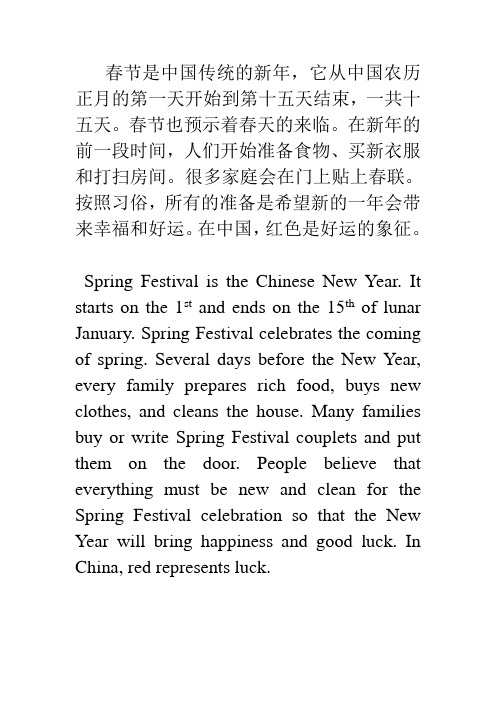
春节是中国传统的新年,它从中国农历正月的第一天开始到第十五天结束,一共十五天。
春节也预示着春天的来临。
在新年的前一段时间,人们开始准备食物、买新衣服和打扫房间。
很多家庭会在门上贴上春联。
按照习俗,所有的准备是希望新的一年会带来幸福和好运。
在中国,红色是好运的象征。
Spring Festival is the Chinese New Year. It starts on the 1st and ends on the 15th of lunar January. Spring Festival celebrates the coming of spring. Several days before the New Year, every family prepares rich food, buys new clothes, and cleans the house. Many families buy or write Spring Festival couplets and put them on the door. People believe that everything must be new and clean for the Spring Festival celebration so that the New Year will bring happiness and good luck. In China, red represents luck.在除夕夜,人们通常要到十二点以后才睡觉,这叫“守岁”,“岁”也是“年”的意思,通常人们用岁表示年龄,即一年是一岁。
守岁是送走旧的一年迎来新的一年,所以在晚上12点时,很多家庭都会放鞭炮以示新的一年的到来。
新年的第一天,也就是初一,人们基本上都呆在家里。
从年初二开始,人们起的很早,互相拜年并致以新年的祝福等。
On New Year’s eve, people set off fireworks from around midnight to see out the end of the previous year and welcome in the New Year, called “shǒusuì” .“suì”means year. On the first day of the New Year people usually stay at home. On the 2nd day people get up early and exchange New Year’s greetings with relatives, friends, neighbors, etc.传统就是,从新年第一天开始直到正月十五,每天都要吃不同的主菜。
春节中英文介绍简短
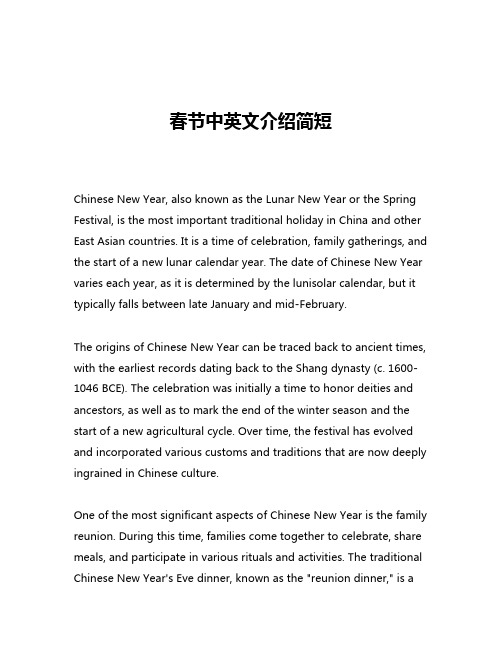
春节中英文介绍简短Chinese New Year, also known as the Lunar New Year or the Spring Festival, is the most important traditional holiday in China and other East Asian countries. It is a time of celebration, family gatherings, and the start of a new lunar calendar year. The date of Chinese New Year varies each year, as it is determined by the lunisolar calendar, but it typically falls between late January and mid-February.The origins of Chinese New Year can be traced back to ancient times, with the earliest records dating back to the Shang dynasty (c. 1600-1046 BCE). The celebration was initially a time to honor deities and ancestors, as well as to mark the end of the winter season and the start of a new agricultural cycle. Over time, the festival has evolved and incorporated various customs and traditions that are now deeply ingrained in Chinese culture.One of the most significant aspects of Chinese New Year is the family reunion. During this time, families come together to celebrate, share meals, and participate in various rituals and activities. The traditional Chinese New Year's Eve dinner, known as the "reunion dinner," is acrucial part of the celebration, where family members gather to enjoy a feast and reflect on the past year.Another important tradition is the giving of red envelopes, or "hong bao," which are small envelopes filled with money. These are typically given by elders to younger family members, as a way to bestow blessings and good luck for the new year. The color red is considered auspicious in Chinese culture, as it symbolizes prosperity, happiness, and good fortune.The decorations and symbols associated with Chinese New Year are also rich in meaning and tradition. The ubiquitous red lanterns, which are hung in homes and public spaces, represent prosperity and good luck. The Chinese character for "happiness" or "good fortune," known as "fu," is often displayed prominently, either as a physical decoration or as a calligraphic work.Another iconic symbol of Chinese New Year is the dragon, which is believed to bring good luck and ward off evil spirits. Dragon dances are a common sight during the celebrations, with performers donning elaborate dragon costumes and maneuvering the dragon through the streets to the sound of drums and cymbals.The celebrations of Chinese New Year extend over a period of 15 days, with each day carrying its own significance and traditions. Thefirst day is typically marked by visits to family members and the exchange of well-wishes. The second day is known as the "welcoming of the gods," and it is a time to honor the Kitchen God, who is believed to report to the Jade Emperor on the family's activities and behavior over the past year.As the celebrations progress, various other customs and activities take place, such as the Lantern Festival on the 15th day, which marks the end of the New Year festivities. During this time, people gatherto admire and release colorful lanterns into the night sky, symbolizing the letting go of the past and the welcoming of a new beginning.The celebrations of Chinese New Year are not limited to China alone. In fact, the festival is celebrated by Chinese communities around the world, with each region or country incorporating its own unique cultural elements and traditions. From the lion dances in Singapore to the fireworks displays in New York City, the global reach of Chinese New Year reflects the rich cultural heritage and the universal appeal of this ancient tradition.In conclusion, Chinese New Year is a deeply meaningful and multifaceted celebration that encompasses a wide range of traditions, customs, and cultural significance. From the family reunions and the exchange of red envelopes to the vibrant decorations and the awe-inspiring dragon dances, the festival offers a glimpse into the rich tapestry of Chinese culture and the enduring spirit of community and tradition. As the world becomes increasingly interconnected, the celebration of Chinese New Year continues to captivate and inspire people of all backgrounds, fostering a greater appreciation for the diversity and richness of human culture.。
春节简介幻灯片(中英对照)

——The End——
This custom shows a good wish of putting away old things to welcome a new life.
守歲
Staying Up Late on New Year's Eve
守歲的傳統來自一 個有趣的民間故事 。在中國古代有一 個叫作“年”的怪 兽。在春節前的晚 上,“年”會從地 洞裡出來吃人。
春节
An Introduction of the Chinese New Year (the Spring Festival)
中国新年——春节
Chinese new year (The Spring Festival) is the
most important festival for Chinese people, just like Christmas in the West.
春節在農曆的一月一日,通常比太陽曆的一月一日
晚一個多月。
掃塵
Sweeping the Dust
“Dust” is homophonic with “chen ( 陳 ) ” in Chinese, which means old and past.
“Sweeping the dust” before the Spring Festival means a thorough cleaning of houses to sweep away bad luck in the past year.
New Hale Waihona Puke ear’s eve for years
New year's Eve is busy, don't forget the god.
英文春节资料带翻译
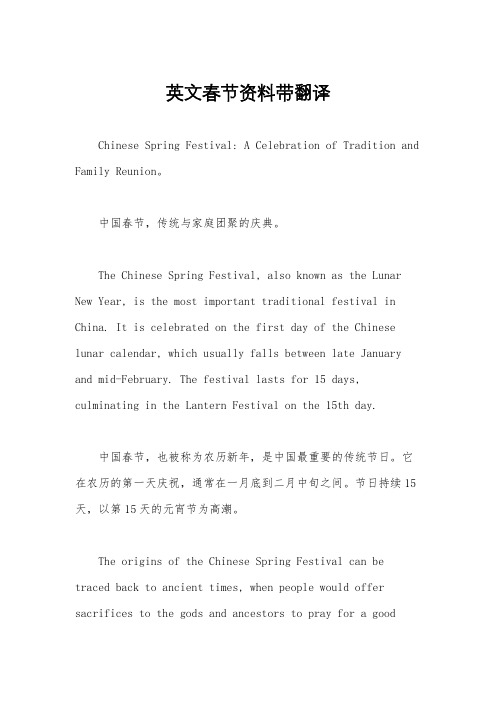
英文春节资料带翻译Chinese Spring Festival: A Celebration of Tradition and Family Reunion。
中国春节,传统与家庭团聚的庆典。
The Chinese Spring Festival, also known as the Lunar New Year, is the most important traditional festival in China. It is celebrated on the first day of the Chinese lunar calendar, which usually falls between late January and mid-February. The festival lasts for 15 days, culminating in the Lantern Festival on the 15th day.中国春节,也被称为农历新年,是中国最重要的传统节日。
它在农历的第一天庆祝,通常在一月底到二月中旬之间。
节日持续15天,以第15天的元宵节为高潮。
The origins of the Chinese Spring Festival can be traced back to ancient times, when people would offer sacrifices to the gods and ancestors to pray for a goodharvest and prosperity in the coming year. Later, it became a time for family reunion, when people would travel long distances to return to their hometowns and spend time with their loved ones.中国春节的起源可以追溯到古代,当时人们会向神灵和祖先祭祀,祈求来年的丰收和繁荣。
The Spring Festival春节介绍(中英文版)
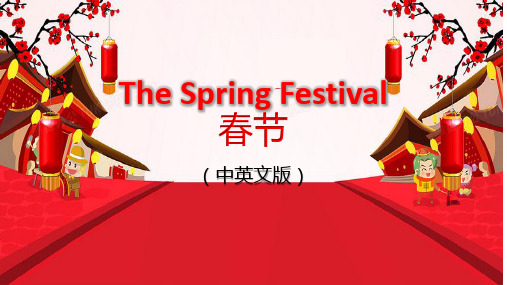
Custom
除夕之夜,全家团聚在一起 吃年夜饭,万家灯火通明,围坐 炉旁闲聊,通宵守夜,象征着团 圆,期待着新的一年吉祥如意。
On New Year's Eve, the whole family gathers together to have a New Year's Eve dinner, with all the lights on. They sit around the fireplace chatting and stay up all night, symbolizing reunion and looking forward to a prosperous new year.
The Spring Festival 春节
(中英文版)
目录
1
Origin
2
Time
3
Significance
4
Custom
春节即中国农历新年,俗称新春、新岁、岁旦等。
The Spring Festival is the Chinese Lunar New Year, commonly known as the new year, the new year, the new year's day and so on.
Origin
据记载,中国人过春节已有4 千多年的历史,它是由虞舜兴起的。
According to records, the Chinese people have celebrated the Spring Festival for more than 4000 years. It was raised by Yu Shun.
Significance
春节是我国民族的传统节日,是 中华民族文化的绘萃。
关于春节的介绍英文版(四句话)
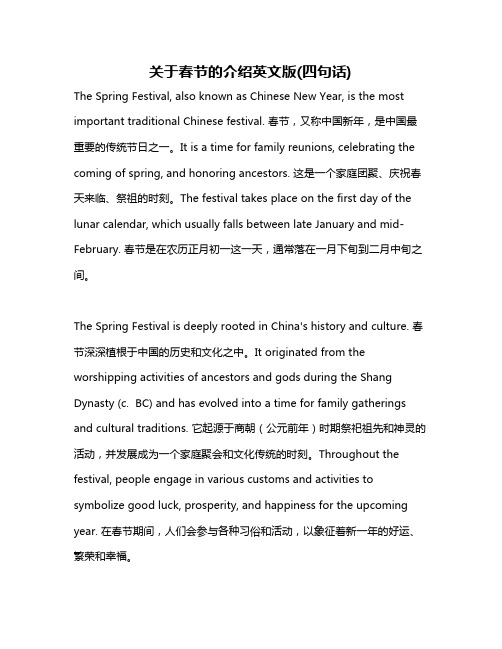
关于春节的介绍英文版(四句话)The Spring Festival, also known as Chinese New Year, is the most important traditional Chinese festival. 春节,又称中国新年,是中国最重要的传统节日之一。
It is a time for family reunions, celebrating the coming of spring, and honoring ancestors. 这是一个家庭团聚、庆祝春天来临、祭祖的时刻。
The festival takes place on the first day of the lunar calendar, which usually falls between late January and mid-February. 春节是在农历正月初一这一天,通常落在一月下旬到二月中旬之间。
The Spring Festival is deeply rooted in China's history and culture. 春节深深植根于中国的历史和文化之中。
It originated from the worshipping activities of ancestors and gods during the Shang Dynasty (c. BC) and has evolved into a time for family gatherings and cultural traditions. 它起源于商朝(公元前年)时期祭祀祖先和神灵的活动,并发展成为一个家庭聚会和文化传统的时刻。
Throughout the festival, people engage in various customs and activities to symbolize good luck, prosperity, and happiness for the upcoming year. 在春节期间,人们会参与各种习俗和活动,以象征着新一年的好运、繁荣和幸福。
用英语介绍过年的传统文化
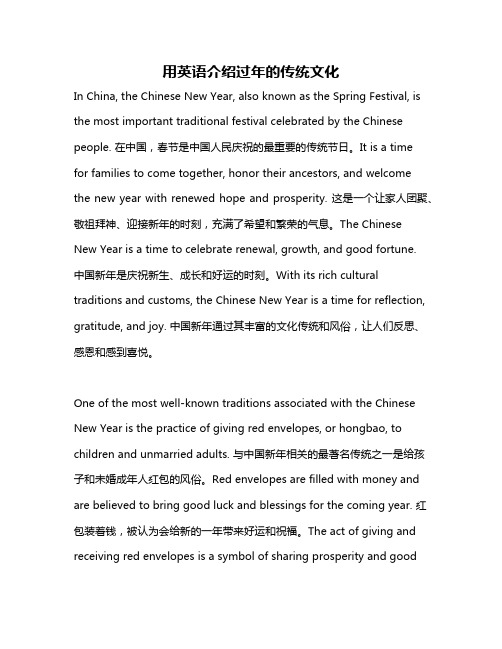
用英语介绍过年的传统文化In China, the Chinese New Year, also known as the Spring Festival, is the most important traditional festival celebrated by the Chinese people. 在中国,春节是中国人民庆祝的最重要的传统节日。
It is a timefor families to come together, honor their ancestors, and welcomethe new year with renewed hope and prosperity. 这是一个让家人团聚、敬祖拜神、迎接新年的时刻,充满了希望和繁荣的气息。
The ChineseNew Year is a time to celebrate renewal, growth, and good fortune.中国新年是庆祝新生、成长和好运的时刻。
With its rich cultural traditions and customs, the Chinese New Year is a time for reflection, gratitude, and joy. 中国新年通过其丰富的文化传统和风俗,让人们反思、感恩和感到喜悦。
One of the most well-known traditions associated with the Chinese New Year is the practice of giving red envelopes, or hongbao, to children and unmarried adults. 与中国新年相关的最著名传统之一是给孩子和未婚成年人红包的风俗。
Red envelopes are filled with money and are believed to bring good luck and blessings for the coming year. 红包装着钱,被认为会给新的一年带来好运和祝福。
英文介绍中国新年的来历

英文介绍中国新年的来历英文介绍中国新年的来历中国新年,也就是春节,是农历正月初一,又叫阴历年,俗称“过年”。
这是我国民间最隆重、最热闹的`一个传统节日。
下面是小编为大家整理的英文介绍中国新年的来历,欢迎阅读。
The Chinese New Year is now popularly known as the Spring Festival because it starts from the Begining of Spring (the first of the twenty-four terms in coodination with the changes of Nature). Its origin is too old to be traced. Several explanations are hanging around. All aGREe, however, that the word Nian, which in modern Chinese solely means "year", was originally the name of a monster beast that started to prey on people the night before the beginning of a new year.One legend goes that the beast Nian had a very big mouth that would swallow a GREat many people with one bite. People were very scared. One day, an old man came to their rescue, offering to subdue Nian. T o Nian he said, "I hear say that you are very capable, but can you swallow the other beasts of prey on earth instead of people who are by no means of your worthy opponents?" So, it did swallow many of the beasts of prey on earth that also harrassed people and their domestic animals from time to time.After that, the old man disappeared riding the beast Nian. He turned out to be an immortal god. Now that Nian is gone and other beasts of prey are also scared into forests, people begin to enjoy their peaceful life. Before the old man left, he had told people to put up red paper decorations on their windows and doors at each year's end to scare away Nian in case it sneaked back again, because red is the color the beast feared the most.From then on, the tradition of observing the conquest of Nian is carried on from generation to generation. The term "Guo Nian", which may mean "Survive the Nian" becomes today "Celebrate the (New) Year" as the word "guo" in Chinese having both the meaning of "pass-over" and "observe". The custom of putting up red paper and firing fire-crackers to scare away Nian should it have a chance to run loose is still around. However, people today have long forgotten why they are doing all this, except that they feel the color and the sound add to the excitement of the celebration.。
中国春节中英介绍短篇
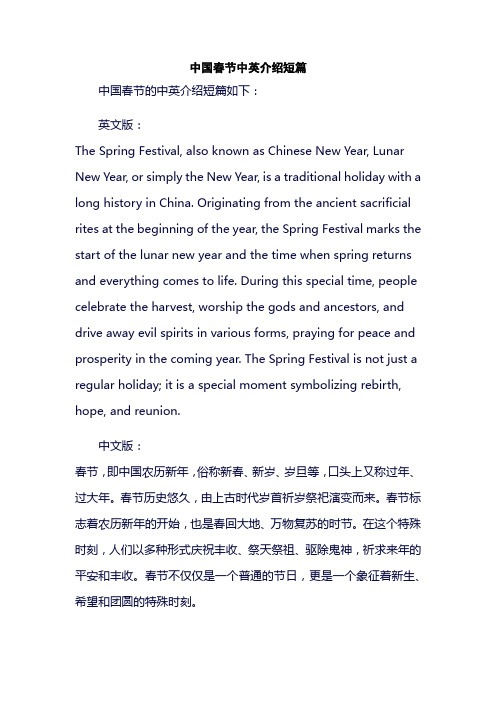
中国春节中英介绍短篇中国春节的中英介绍短篇如下:英文版:The Spring Festival, also known as Chinese New Year, Lunar New Year, or simply the New Year, is a traditional holiday with a long history in China. Originating from the ancient sacrificial rites at the beginning of the year, the Spring Festival marks the start of the lunar new year and the time when spring returns and everything comes to life. During this special time, people celebrate the harvest, worship the gods and ancestors, and drive away evil spirits in various forms, praying for peace and prosperity in the coming year. The Spring Festival is not just a regular holiday; it is a special moment symbolizing rebirth, hope, and reunion.中文版:春节,即中国农历新年,俗称新春、新岁、岁旦等,口头上又称过年、过大年。
春节历史悠久,由上古时代岁首祈岁祭祀演变而来。
春节标志着农历新年的开始,也是春回大地、万物复苏的时节。
在这个特殊时刻,人们以多种形式庆祝丰收、祭天祭祖、驱除鬼神,祈求来年的平安和丰收。
春节不仅仅是一个普通的节日,更是一个象征着新生、希望和团圆的特殊时刻。
中国新年----英文介绍
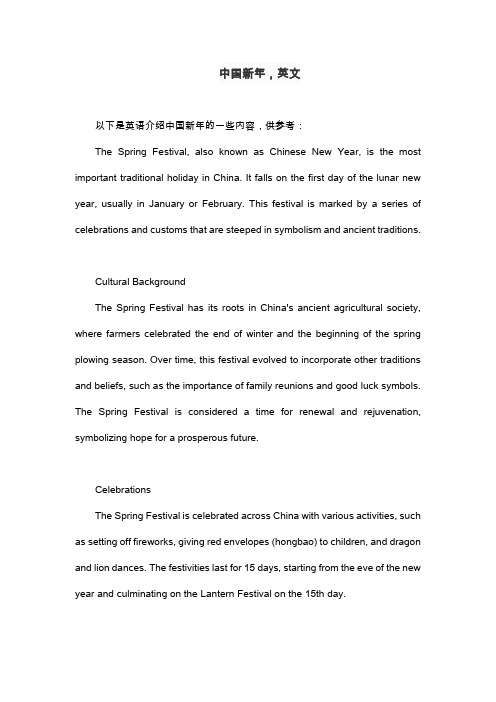
中国新年,英文以下是英语介绍中国新年的一些内容,供参考:The Spring Festival, also known as Chinese New Year, is the most important traditional holiday in China. It falls on the first day of the lunar new year, usually in January or February. This festival is marked by a series of celebrations and customs that are steeped in symbolism and ancient traditions.Cultural BackgroundThe Spring Festival has its roots in China's ancient agricultural society, where farmers celebrated the end of winter and the beginning of the spring plowing season. Over time, this festival evolved to incorporate other traditions and beliefs, such as the importance of family reunions and good luck symbols. The Spring Festival is considered a time for renewal and rejuvenation, symbolizing hope for a prosperous future.CelebrationsThe Spring Festival is celebrated across China with various activities, such as setting off fireworks, giving red envelopes (hongbao) to children, and dragon and lion dances. The festivities last for 15 days, starting from the eve of the new year and culminating on the Lantern Festival on the 15th day.Traditional CustomsOne of the most important customs during the Spring Festival is to clean the house, symbolizing the sweeping away of bad luck and welcoming good luck in the new year. People also post red couplets on their doors, which contain phrases wishing good luck and prosperity. Another common practice is to have a reunion dinner on New Year's Eve, which is usually a feast featuring dishes that symbolize good luck and prosperity, such as fish and nian gao.Food FestivalThe Spring Festival is also known as a food festival because of the array of delicious dishes that are prepared during this time. Dishes such as fish, nian gao, dumplings, and spring rolls are traditional foods that are eaten during this holiday. These dishes are not only delicious but also have symbolic meanings, representing prosperity, health, and family unity.Looking to the FutureAs we bid farewell to the old year and usher in the new, it's natural to reflect on the past and contemplate the future. The Spring Festival offers an opportunity to take stock of our personal and collective achievements over the past year and set new goals for the year ahead. It's a time to make resolutions, such as improving one's health, pursuing new hobbies, or achieving professional goals.New Year's MessageAs we step into the new year, may your days be filled with joy, love, and laughter. May you find success in all your endeavors and may good fortune smile upon you. May you cherish the simple things in life and make the most of every opportunity that comes your way. Happy New Year!ConclusionIn conclusion, the Spring Festival is a time for family reunions, feasting, and celebrating good luck and prosperity. It's a window into China's rich cultural heritage, where ancient traditions are upheld and celebrated with gusto. As we celebrate the new year, may all your wishes come true and may you enjoy health, prosperity, and happiness in the year to come.希望以上内容对您有所帮助。
介绍中国的新年英语作文及翻译(精选10篇)
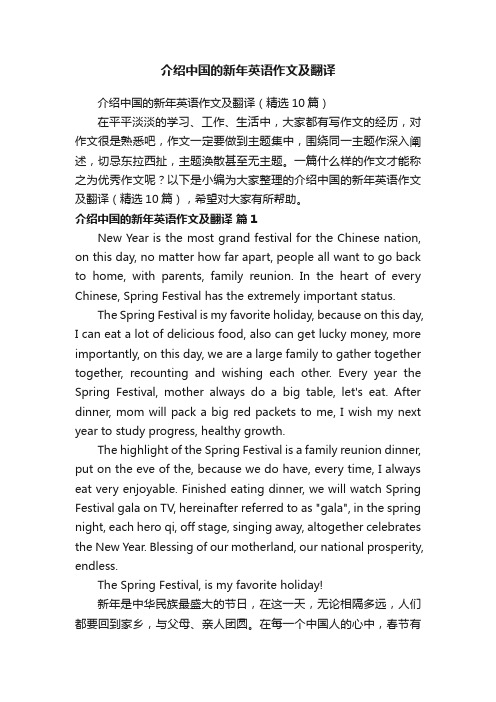
介绍中国的新年英语作文及翻译介绍中国的新年英语作文及翻译(精选10篇)在平平淡淡的学习、工作、生活中,大家都有写作文的经历,对作文很是熟悉吧,作文一定要做到主题集中,围绕同一主题作深入阐述,切忌东拉西扯,主题涣散甚至无主题。
一篇什么样的作文才能称之为优秀作文呢?以下是小编为大家整理的介绍中国的新年英语作文及翻译(精选10篇),希望对大家有所帮助。
介绍中国的新年英语作文及翻译篇1New Year is the most grand festival for the Chinese nation, on this day, no matter how far apart, people all want to go back to home, with parents, family reunion. In the heart of every Chinese, Spring Festival has the extremely important status.The Spring Festival is my favorite holiday, because on this day, I can eat a lot of delicious food, also can get lucky money, more importantly, on this day, we are a large family to gather together together, recounting and wishing each other. Every year the Spring Festival, mother always do a big table, let's eat. After dinner, mom will pack a big red packets to me, I wish my next year to study progress, healthy growth.The highlight of the Spring Festival is a family reunion dinner, put on the eve of the, because we do have, every time, I always eat very enjoyable. Finished eating dinner, we will watch Spring Festival gala on TV, hereinafter referred to as "gala", in the spring night, each hero qi, off stage, singing away, altogether celebrates the New Year. Blessing of our motherland, our national prosperity, endless.The Spring Festival, is my favorite holiday!新年是中华民族最盛大的节日,在这一天,无论相隔多远,人们都要回到家乡,与父母、亲人团圆。
中国春节英语介绍Spring Festival Day
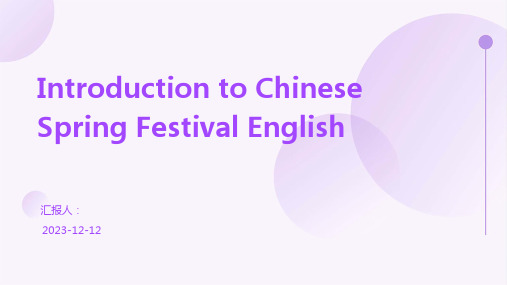
03
The History and Cultural Conno
The Historical Background of t
The historical origin of the Spring Festival: The Spring Festival originated from the annual customs of ancient agricultural societies and has a long history. In China, the Spring Festival is considered one of the most important traditional festivals and the most celebrated festival nationwide.
During the Spring Festival, dragon and lion dances are performed in the streets to celebrate the New Year These performances are believed to bring good luck and confusion to the audience
Introduction to Chinese Spring Festival English
汇报人: 2023-12-12
目 录
• The Origin and Development of • The Celebration Activities and • The History and Cultural Conno • The Celebration Methods and In
Traditional cuisine and culture
向外国人介绍中国新年的英语作文

向外国人介绍中国新年的英语作文Celebrating the Chinese New YearHi there! My name is Xiao Ming and I'm 10 years old. I live in Beijing, China with my mom, dad, and little sister. Today I want to tell you all about how we celebrate the Chinese New Year in my family. It's one of the most important holidays we have!The Chinese New Year is also called the Spring Festival. It marks the beginning of a new year on the traditional Chinese calendar. The date changes every year, but it's always sometime in late January or early February based on the lunar cycle. This year it fell on January 22nd.Preparing for the New Year is a really big deal in Chinese culture. We have many traditions and superstitions surrounding the holiday. For example, a few weeks before New Year's Day, my mom starts a major cleaning of our whole house from top to bottom. She says this sweeps away any bad luck from the old year to make way for good incoming fortune. My dad puts up red decorations everywhere - red is considered a very lucky color in China. We hang up red lanterns, red scrolls with couplets written on them, and paper cut-outs of the Chinese character for "happiness."My favorite part of the preparations is watching my mom make dumplings from scratch. She mixes together a dough of flour and water, then rolls it out into little circle wrappers. She puts a savory filling of pork, cabbage, and spices into each one before pinching them shut into little pouches. I love helping her crimp the edges with a fork. My sister and I can never get enough of eating dumplings! They're so delicious, especially when dipped in a mixture of soy sauce, vinegar, and chili oil. My aunt told me that dumplings are shaped like old-fashioned money and symbolize wealth in the new year. Pretty cool, huh?On New Year's Eve, my whole extended family gathers together at my grandparents' house for a huge feast. All my aunts, uncles, and cousins come over too. The meal has so many different dishes - a whole fish for prosperity, long noodles for longevity, niangao (a sweet sticky rice cake) for increasing income, and dumplings of course. My grandma always gives the kids little red envelopes filled with "lucky money." She says it's for blessing us with a safe and prosperous year ahead.After dinner, the real fun begins - we kids get to stay up way past our bedtimes! At midnight, fireworks and firecrackers start going off everywhere outside. They're meant to scare away evil spirits and mark the new year rolling in. My cousins and I taketurns lighting off our own sparklers and poppers. It's so loud and colorful! Then we rush back inside to watch the New Year's TV gala. It's a huge variety show with singing, dancing, comedy sketches, and special segments celebrating Chinese culture and history. Even though some parts are kind of cheesy, it's still really exciting to experience the countdown to the new year along with the rest of the nation.The following two weeks are treated like an extended holiday for visiting relatives, relaxing at home, and having fun. On the first day, my family puts on our best clothes and gives each other deep bows while saying "Gong Xi Fa Cai" (which means "Congratulations and be prosperous"). We hand out more red envelopes filled with cash, eat sweet snacks like sesame seed balls, and watch more New Year's programming on TV. Each day after that has its own customs too. One day we honor the God of Wealth, another day we pray to the Jade Emperor of Heaven. Married couples visit the wife's side of the family, then the next day they visit the husband's side. On the 15th day, we celebrate the Lantern Festival by eating sweet rice balls, guessing riddles on folding paper lanterns, and watching incredible dragon dances under the full moon. It's beautiful!So that's the Chinese New Year in a nutshell! Over these two weeks, we eat lots of delicious food, spend quality time with loved ones, and partake in ancient traditions for luck, health and prosperity in the upcoming year cycle. Even though some parts are definitely just superstitions, I love how the holiday brings my whole family together to connect with our heritage and culture. Let me know if you have any other questions - I'm always happy to share more about my favorite time of the year!。
中国传统节日
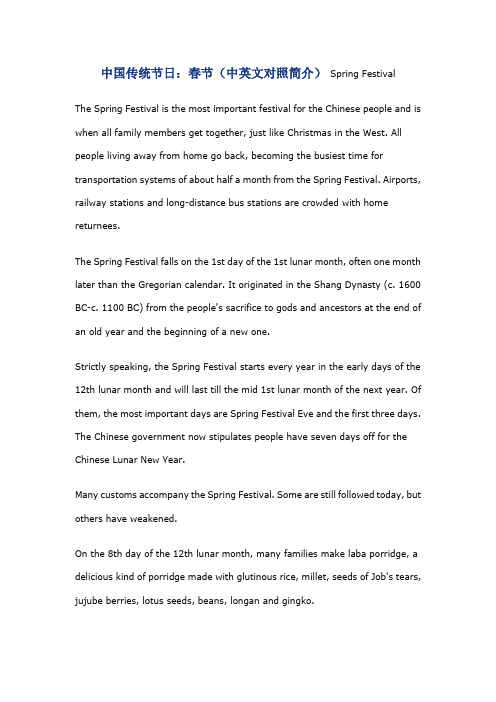
中国传统节日:春节(中英文对照简介)Spring FestivalThe Spring Festival is the most important festival for the Chinese people and is when all family members get together, just like Christmas in the West. All people living away from home go back, becoming the busiest time for transportation systems of about half a month from the Spring Festival. Airports, railway stations and long-distance bus stations are crowded with home returnees.The Spring Festival falls on the 1st day of the 1st lunar month, often one month later than the Gregorian calendar. It originated in the Shang Dynasty (c. 1600 BC-c. 1100 BC) from the people's sacrifice to gods and ancestors at the end of an old year and the beginning of a new one.Strictly speaking, the Spring Festival starts every year in the early days of the 12th lunar month and will last till the mid 1st lunar month of the next year. Of them, the most important days are Spring Festival Eve and the first three days. The Chinese government now stipulates people have seven days off for the Chinese Lunar New Year.Many customs accompany the Spring Festival. Some are still followed today, but others have weakened.On the 8th day of the 12th lunar month, many families make laba porridge, a delicious kind of porridge made with glutinous rice, millet, seeds of Job's tears, jujube berries, lotus seeds, beans, longan and gingko.The 23rd day of the 12th lunar month is called Preliminary Eve. At this time, people offer sacrifice to the kitchen god. Now however, most families make delicious food to enjoy themselves.After the Preliminary Eve, people begin preparing for the coming New Year. This is called "Seeing the New Year in".Store owners are busy then as everybody goes out to purchase necessities for the New Year. Materials not only include edible oil, rice, flour, chicken, duck, fish and meat, but also fruit, candies and kinds of nuts. What's more, various decorations, new clothes and shoes for the children as well as gifts for the elderly, friends and relatives, are all on the list of purchasing.Before the New Year comes, the people completely clean the indoors and outdoors of their homes as well as their clothes, bedclothes and all their utensils.Then people begin decorating their clean rooms featuring an atmosphere of rejoicing and festivity. All the door panels will be pasted with Spring Festival couplets, highlighting Chinese calligraphy with black characters on red paper. The content varies from house owners' wishes for a bright future to good luck for the New Year. Also, pictures of the god of doors and wealth will be posted on front doors to ward off evil spirits and welcome peace and abundance.The Chinese character "fu" (meaning blessing or happiness) is a must. The character put on paper can be pasted normally or upside down, for in Chinese the "reversed fu" is homophonic with "fu comes", both being pronounced as"fudaole." What's more, two big red lanterns can be raised on both sides of the front door. Red paper-cuttings can be seen on window glass and brightly colored New Year paintings with auspicious meanings may be put on the wall.People attach great importance to Spring Festival Eve. At that time, all family members eat dinner together. The meal is more luxurious than usual. Dishes such as chicken, fish and bean curd cannot be excluded, for in Chinese, their pronunciations, respectively "ji", "yu" and "doufu," mean auspiciousness, abundance and richness. After the dinner, the whole family will sit together, chatting and watching TV. In recent years, the Spring Festival party broadcast on China Central Television Station (CCTV) is essential entertainment for the Chinese both at home and abroad. According to custom, each family will stay up to see the New Year in.Waking up on New Year, everybody dresses up. First they extend greetings to their parents. Then each child will get money as a New Year gift, wrapped up in red paper. People in northern China will eat jiaozi, or dumplings, for breakfast, as they think "jiaozi" in sound means "bidding farewell to the old and ushering in the new". Also, the shape of the dumpling is like gold ingot from ancient China. So people eat them and wish for money and treasure.Southern Chinese eat niangao (New Year cake made of glutinous rice flour) on this occasion, because as a homophone, niangao means "higher and higher, one year after another." The first five days after the Spring Festival are a good time for relatives, friends, and classmates as well as colleagues to exchange greetings, gifts and chat leisurely.Burning fireworks was once the most typical custom on the Spring Festival. People thought the spluttering sound could help drive away evil spirits. However, such an activity was completely or partially forbidden in big cities once the government took security, noise and pollution factors into consideration. As a replacement, some buy tapes with firecracker sounds to listen to, some break little balloons to get the sound too, while others buy firecracker handicrafts to hang in the living room.The lively atmosphere not only fills every household, but permeates to streets and lanes. A series of activities such as lion dancing, dragon lantern dancing, lantern festivals and temple fairs will be held for days. The Spring Festival then comes to an end when the Lantern Festival is finished.China has 56 ethnic groups. Minorities celebrate their Spring Festival almost the same day as the Han people, and they have different customs.春节,是农历正月初一,又叫阴历年,俗称“过年”。
中国春节英文介绍..带翻译的
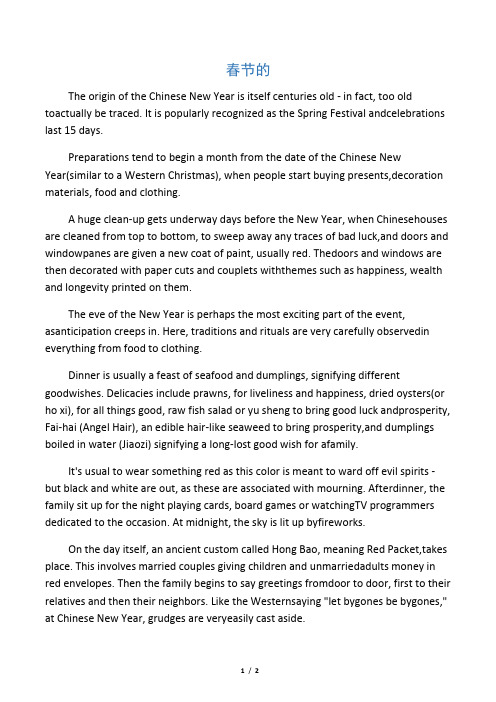
春节的The origin of the Chinese New Year is itself centuries old - in fact, too old toactually be traced. It is popularly recognized as the Spring Festival andcelebrations last 15 days.Preparations tend to begin a month from the date of the Chinese NewYear(similar to a Western Christmas), when people start buying presents,decoration materials, food and clothing.A huge clean-up gets underway days before the New Year, when Chinesehouses are cleaned from top to bottom, to sweep away any traces of bad luck,and doors and windowpanes are given a new coat of paint, usually red. Thedoors and windows are then decorated with paper cuts and couplets withthemes such as happiness, wealth and longevity printed on them.The eve of the New Year is perhaps the most exciting part of the event, asanticipation creeps in. Here, traditions and rituals are very carefully observedin everything from food to clothing.Dinner is usually a feast of seafood and dumplings, signifying different goodwishes. Delicacies include prawns, for liveliness and happiness, dried oysters(or ho xi), for all things good, raw fish salad or yu sheng to bring good luck andprosperity, Fai-hai (Angel Hair), an edible hair-like seaweed to bring prosperity,and dumplings boiled in water (Jiaozi) signifying a long-lost good wish for afamily.It's usual to wear something red as this color is meant to ward off evil spirits -but black and white are out, as these are associated with mourning. Afterdinner, the family sit up for the night playing cards, board games or watchingTV programmers dedicated to the occasion. At midnight, the sky is lit up byfireworks.On the day itself, an ancient custom called Hong Bao, meaning Red Packet,takes place. This involves married couples giving children and unmarriedadults money in red envelopes. Then the family begins to say greetings fromdoor to door, first to their relatives and then their neighbors. Like the Westernsaying "let bygones be bygones," at Chinese New Year, grudges are veryeasily cast aside.The end of the New Year is marked by the Festival of Lanterns, which is acelebration with singing, dancing and lantern shows.Although celebrations of the Chinese New Year vary, the underlying messageis one of peace and happiness for family members and friends.农历新年的起源是它几个世纪的历史岁月,事实上,这由于年代过于久远而无法被准确的追溯。
- 1、下载文档前请自行甄别文档内容的完整性,平台不提供额外的编辑、内容补充、找答案等附加服务。
- 2、"仅部分预览"的文档,不可在线预览部分如存在完整性等问题,可反馈申请退款(可完整预览的文档不适用该条件!)。
- 3、如文档侵犯您的权益,请联系客服反馈,我们会尽快为您处理(人工客服工作时间:9:00-18:30)。
中国新年Every winter, a sixth of the world's population, including more than one billion Chinese citizens, celebrate Chinese New Year. The 15-day festival, also known as Lunar New Year or the Spring Festival, kicks off on the second new moon after the winter solstice, or according to the Gregorian calendar in use since the 16th century, sometime between January 21 and February 19. But Chinese New Year goes back a lot further than the 16th century—it's based on the ancient Chinese calendar, which existed as early as the 14th century BC. Even though China adopted the Western calendar in 1912 and began marking January 1 as the official start of the year, Chinese New Year remains the country's most important social and economic holiday.每年冬天,全世界六分之一的人口,包含超过十亿中国人,庆祝中国新年。
这持续十五天的节日,又称作农历新年或春节,在冬至后的第二个新月开始,或根据十六世纪开始使用的公历,中国新年大约落在一月二十一号和二月十九号间。
不过中国新年可回溯至十六世纪更久远以前——它是以中国古老历法为根据,那早在西元前十四世纪就存在。
即使中国在1912年采用西洋历法,并开始将一月一号标为正式的一年之始,中国新年仍是国家最重要的社交和商业节庆。
Over the centuries, holiday festivities have spread far beyond China and now take place all over the world. In fact, the biggest celebration outside of China takes place in the United States—San Francisco to be exact. Ever since the Gold Rush in the 1840s and '50s brought an influx of Chinese immigrant workers to Northern California, the city has held a massive parade for Chinese New Year. 几世纪来,节日庆典已远布至中国以外的地方,如今在全世界举行。
事实上,中国外最大的庆典就在美国举行——准确点说是在旧金山。
自1840和1850年代的淘金热将大量中国移工带到北加州后,旧金山这城市就为中国新年举办盛大的游行活动。
According to Chinese tradition, each year is named for one of the 12 animals associated with the Chinese zodiac. Two of those animals, the dragon and the rabbit, are particularly important to Chinese New Year. You'll see dragons everywhere, because the Chinese are said to have descended from the mythical creature. And on the 15th day of the New Year, known as the Festival of Lanterns, many people display paper lanterns in the shape of rabbits. These symbolize a Chinese goddess named Chang'e, who is said to have brought a rabbit along with her when she jumped on the moon.依照中国传统,每年是以和中国生肖有关的十二种动物之一命名。
那其中两种动物,龙和兔,对中国新年特别重要。
你在任何地方都会看到龙,因为中国人据说是这种玄妙生物的后代。
而在新年的第十五天,称作灯节,许多人展示出以兔为形的纸灯笼。
这些象征一位名为嫦娥的中国女神,据说她在跳到月亮时带了只兔子一起。
To prepare for Chinese New Year, lots of people clean out their houses to rid them of ghosts and bad luck associated with the old year. They might get a new haircut and clothes, settle disagreements, or pay off debts in order to start the year fresh. In this way, the Chinese New Year customs resemble the Western custom of New Year's resolutions.为了准备过中国新年,许多人打扫房子以除去和旧的一年有关的鬼魂和厄运。
他们可能会剪个新发型和买新衣、化解纷争,或还清债务好有个新年新气象。
就这方面,中国新年的习俗和西方的新年新希望习俗相似。
In the late-night hours of Chinese New Year's Eve, many families make dumplings together. This food is said to bring good fortune to the household. Long noodles are also a traditional Chinese New Year's dish. But if you wanna live a long life, never cut the noodles while eating them. And be sure to wear red, the color of good luck, and avoid black, which many people associate with death. Whether they're superstitions or resolutions, one thing's for sure: There's a lot of tradition associated with Chinese New Year that we bet you didn't know!在除夕的深夜,许多家庭会一起包饺子。
据说这种食物会带给家庭好运。
长寿面也是传统的中国新年料理。
不过如果你想要长命百岁,永远不要在吃长寿面时把面条咬断。
务必穿着红色,喜气的颜色,并避免黑色,许多人将黑色和死亡联想在一起。
无论那些是迷信或决心,有件事是毫无疑问的:有许多和中国新年相关的传统,我们敢说你不知道!重点内容讲解1.kick off开始例句:The 15-day festival, also known as Lunar New Year or the Spring Festival, kicks off on the second new moon after the winter solstice...这持续十五天的节日,又称作农历新年或春节,在冬至后的第二个新月开始……2.in use被使用、通用例句:...or according to the Gregorian calendar in use since the 16th century, sometime between January 21 and February 19....或根据十六世纪开始使用的公历,中国新年大约落在一月二十一号和二月十九号间。
3.base on根据、以……为基础例句:But Chinese New Year goes back a lot further than the 16th century—it's based on the ancient Chinese calendar...不过中国新年可回溯至十六世纪更久远以前——它是以中国古老历法为根据...4.take place举行、发生例句:Over the centuries, holiday festivities have spread far beyond China and now take place all over the world.几世纪来,节日庆典已远佈至中国以外的地方,如今在全世界举行。
5.clean out打扫、清除例句:To prepare for Chinese New Year, lots of people clean out their houses to rid them of ghosts and bad luck associated with the old year.为了准备过中国新年,许多人打扫房子以除去和旧的一年有关的鬼魂和厄运。
6.rid of 除去例句:To prepare for Chinese New Year, lots of people clean out their houses to rid them of ghosts and bad luck associated with the old year.为了准备过中国新年,许多人打扫房子以除去和旧的一年有关的鬼魂和厄运。
